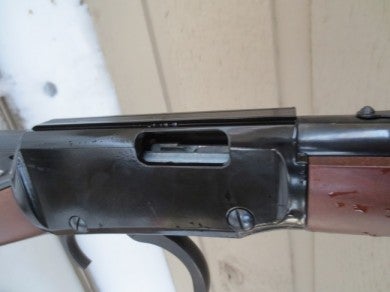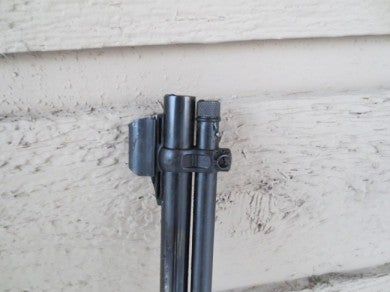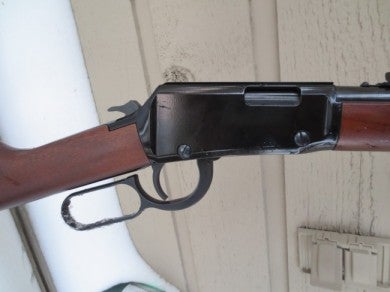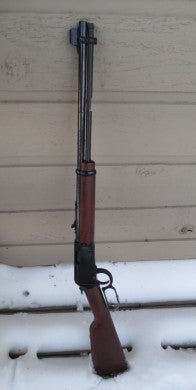What makes the Henry .22 lever rifle so alluring? Perhaps is the time that it brings to mind: the days of Cowboys and Indians, no seat belts, and slower life? Is it because the Henry is 100% American made, solid, and fantastic value? Or maybe it’s versatile, easy to handle, and practical?
Capable of handling 22 Long Rifle, 22 Long, and 22 Short, the Henry is a model of days past. Inspired by the original Henry Repeating Rifle, the Classic Lever Action (Model H001) is capable of rapid, accurate rimfire fire. The Classic Rimfire is a testament to over 150 years of Henry rifles, trusted during the Civil War and the Great Expansion into the Wild West. There are a few faults in this value-oriented rifle but taken in context of the same, there are few that can beat it.
Shooting the Henry
After waiting the last two weeks for the weather to be clear enough to go to the outdoor range, I finally broke down and headed to an indoor range. While I have shot the Henry past 100 yards out in the country, I finally had a selection of .22lr and .22 Short brands to test the Henry’s feeding and accuracy.
Loading the rifle is a simple affair. To open up the tubular magazine, twist the end cap off the muzzle end of the tube and pull the brass inner tube and spring out. You can opt to leave it in the magazine, but it can become unwieldy when loading rounds. Rounds are dropped into the magazine tube through the loading port, conveniently cut to the size of a 22LR round. There are specific cuts for the rounds’ rims, so a shooter cannot accidentally load them backwards. After rounds are loaded up to the port, insert the inner brass tube and twist to lock the complete assembly in place. The Henry can hold 15 22LR, 17 22L, or 21 22S in the tube.
Chambering live rounds is accomplished through cycling the lever, which has an approximately 75-degree, surprisingly smooth action. As with all lever actions, on the lever down stroke, the spent casing is extracted and on the up stroke a new cartridge is chambered. The lever locks into battery with a firm and quite audible click.
In Long Rifle, I had CCI Mini Mags (HP), Federal Champion Bulk Pack (HP), Remington Thunderbolts (HP), and CCI Blazer (LRN). To supplement the LR, I had about 50 rounds of CCI Short HP, and some 50 year old unknown brand shorts from grandpa just to test cycling. All shots were fired from a Caldwell “7” rest using the stock iron sights. For each 22LR, I shot five five-round groups. For 22 Short, three five-round groups.
At 25 yards at the indoor range, the CCI Mini Mags produced the best groupings (average .78”) with the CCI Blazer LRN coming in close second (.85”). The two bulk pack boxes also shot well, coming in at 1.01” and 1.15” for the Federal and Remington, respectively. The 22 Shorts were about 1.1” each, including the old ammo. I suspect the groups could be tightened up through the use of a receiver-mounted scope. I found the front sight post fat and difficult to see clearly on a black target.
During the accuracy test, there were no extraction issues, but the rifle did fail to chamber two Remington Thunderbolts. On closer examination, it looked like the brass was dented, but that could have been caused by the bolt trying to chamber the round. There were no issues with the 22 shorts, including the grody 50-year-old ammo. During the range session there were no failures to fire, but it’s worth mentioning that I have had the typical occasional bad round over the roughly 2000 I have put through the rifle to date. The failures did not look to be a light primer strikes and did not fire after manually cocking the hammer again.
Finding a Few Faults
Other reviews have faulted the Henry for “cheap” materials or poor fit and finish, but I believe it is important to recognize that trade-offs are necessary to reach the Henry’s price point. When viewed from this perspective, I find no major faults with the design, materials, or finish. Henry uses steel where they have to and cheaper materials where they can.

The action open, showing the cast interior parts. Despite the less expensive materials, the rifle had no feeding or extraction issues.
The receiver is a painted alloy (my wife put some minor scratches into the receiver when she picked it up with her wedding ring on). When viewed from the ejection port one internal parts looking to be injection-molded metals. The edges of the loading port and front sight hood are rough; the shooter should be careful when attempting to remove the front sight hood to avoid being cut. Finally, the front wood hand guard was slightly loose.
The Henry does require the shooter to be mindful. The rifle has no external safety but it does have a half-cock position that requires the trigger to be pulled and the hammer rode down with the thumb. Also, when loading, it is easy to flag yourself. With no external safety, ensure that the rifle is unloaded and either half-cocked or lever open when loading.
Of note, the sights are rudimentary. The front sight post is non-adjustable, molded directly into the front plastic barrel band. The rear is a typical ramp-adjustable dovetail, which is raised via the ramp and can be drifted slightly for windage. My rifle had just enough drift to bring the sights to point-of-aim & impact. The rear sight is not protected or locked down so it may require re-zero if you hit it by accident. Hi-Viz offers both front and rear sights through Henry. The Hi-Viz rear sights are much easier to drift and offer more adjustability. For $50, they shore up the only major fault I have with the Henry.
Pros Outweigh the Cons
I believe we are sometimes conditioned that cheap rifles will mean equally cheap triggers. I was pleasantly surprised to find the Henry has a great trigger. My rifle has a short, smooth take-up of about 1mm and a crisp break around 5 lbs. It was easy to feel the breaking point, even through gloves when outdoors in the cold. The only better breaking triggers I have used are high-end AR bang-switches from HiperFire and Geissele or those on bolt-actions. There is significant over-travel, but I don’t mind since you have to use the firing hand to cycle the action. There is no need for semi-auto reset.
The barrel has a uniform blued finish, lightly crowned for accuracy. At 18 ½ inches, I found it the ideal balance of weight and performance, eeking out all of the velocity 22LR can manage. The barrel has no play relative to the receiver and I did not experience any flyers during accuracy testing.
Outside of the play on the front hand guard, the rifle has absolutely no wobble. The real walnut stock is solid, with just enough of a concave bend to shoulder naturally without being too “pointy” at the top and bottom to hurt if you bring it up incorrectly. The lever is rounded nicely, with no sharp edges to cut your fingers when cycling the action.
On a personal note, I enjoy that the lever pivots on a single point in the receiver with the trigger in the same position instead of some lever actions that have multiple pivot points or triggers that say attached to the lever.
The biggest stand-out feature is the price. With a street price of $275-$300 at a local gun shop, the Henry is a fantastic value. I picked up mine at the local Wal-Mart for $290. As a testament to their popularity, to find one I had to call all of the stores in a 50 mile radius! For those who shop digitally, the Henry can be found online for around $250, before shipping.
Final Thoughts
The Henry is a solid offering: easy to operate, lightweight, grin-inducing lever action, accurate, and priced right. Handling is intuitive, smooth lever action, and a surprisingly good trigger round out the solid offering.
While my ultimate plinker is a semi-auto, my Henry is easily the number two and is a nice change of pace from modern plastic fantastics. I will not fault the Henry for its lever action; it is simply the case of new technologies have been developed on top old. In much the same way, new cars are faster & more efficient compared to the Model –T.
Still something inexorably draws me to the rifle. The Henry draws a giddy smile every time the lever is cycled. With each pull of the trigger the shooter is pulled back for to simpler times.
Bottom line: wholly American-made with American spirit, this Henry is priced just right to find a nostalgic place in your safe… and heart.
Manufacturer Specifications:
| Model Number | H001 |
| Action Type | Lever Action |
| Caliber | .22 |
| Capacity | 15 rounds .22LR, 17 rounds .22L, 21 rounds .22S |
| Length | 36 ½” |
| Barrel Length | 18 ¼” |
| Weight | 5.25 lbs. |
| Stock | Straight-grip American walnut |
| Sights | Adjustable rear, hooded front sight |
| Finish | Blued barrel and lever |
| Price | $360.00 (Street Price: ~$275.00) |
| Henry Lever Carbine Rifle | |
| Model Number | H001L |
| Barrel Length | 16.125″ |
| Weight | 4.5 lbs. |
| M.S.R.P.* | $375.00 (Street ~$300.00) |
 Your Privacy Choices
Your Privacy Choices







